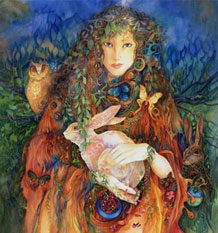
Image of the goddess Eostre by artist Helena Nelson-Reed
Goddess of Easter shines light on collective Christian worship
Millions of people will be tucking into chocolate eggs this Easter, but very few may be aware of the Pagan influence on the Christian festival.
University of Exeter literary scholar Professor Marion Gibson explores the link between the Goddess Eostre, the timing of Easter and the drive for early Christians to create a unified calendar of religious events.
In her new book Imagining the Pagan Past: Gods and Goddesses in Literature and History Since the Dark Ages, Professor Gibson reveals the change from Pagan idol worship to the conversion to Christianity, which was documented by monks. The month of April was chosen for the Anglo-Saxon celebration of the new Christian festival Easter. But surprisingly, a contemporary monastic writer tells us that the name Easter was carried over from Eostre, a Pagan goddess. This might seem odd, but such blending of old and new traditions helped to incorporate Pagans into Christian worship.This was in accordance with the Pope’s instructions to connect with the local community and use, rather than destroy, Pagan temples, as well as adapt Pagan rituals and incorporate into Christian practices.
At this time Christ had been dead for over 700 years, and for several centuries monks from different sects within the Christian church celebrated major Christian feast days, like Easter, at differing times. The Northumbrian eighth-century monk and chronicler, Bede, was focused on setting exact dates and synchronising religious practices and festivals, to help bring European Christianity together in order to create a distinctive period of worship. A set time needed to be chosen for the Roman Pope to bring together the entire Catholic community, especially for the principal feast day of Easter.
According to Bede, the early Christian church debated the use of Pagan rituals and traditions in Christianity. Missionary Christians in Britain and elsewhere frequently got letters from Rome issuing instructions on how to convert Pagans, with suggestions that they should accommodate some of the local Pagan practices: excluding idolatry, but merging elements of pagan faith with elements of Christianity. Bede’s main concern was how to turn Pagans from worshipping multiple gods to only honouring Christ. But ironically he preserved the name of one of the old deities, the goddess Eostre, in his written explanation for the name of the new Christian British festival.
Bede preserved Eostre’s name because he was explaining how he had found the local Pagan religious calendar useful in establishing the proper dates for Christian festivals. In Bede’s work, On the Reckoning of Time, the chronicler listed the months under their English names and explained the names of many of them. May was called Thrimilchi (the time of year where cattle could be milked three times a day),and April, the month in which Easter usually falls, was named Eosturmonath after the pagan goddess Eostre, Bede wrote.
Perhaps it is this continuity that saw the survival and growth of the Christian faith.
Professor Gibson explained:“Bede’s works set up the British Christian calendar as it exists today. When we see the Archbishop of Canterbury or the Pope addressing the entire Christian community at once, we can see why Bede wanted to set an exact, correct time for the celebration of Easter:it brings everyone together. And in doing so, Bede also recorded the name of an old Pagan goddess whose celebration had helped him to set the right time for Easter. Pagan religions were often focused on both gods and goddesses, and by continuing to call Easter after an older name he lets us see a glimpse of an older female-focused festival that became our Easter.”
Date: 28 March 2013
